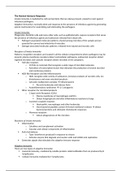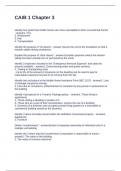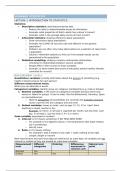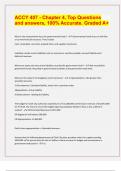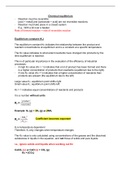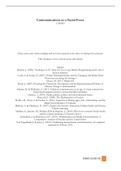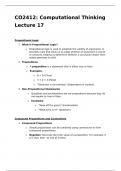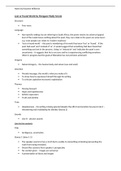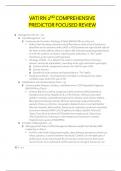Innate immunity is mediated by cells and proteins that are always present, poised to react against
infectious pathogens.
Adaptive immunity is normally silent and response to the presence of infectious agents by generating
potent mechanisms for neutralizing and eliminating the pathogens.
Innate immunity
Phagocytes, dendritic cells and many other cells, such as epithelial cells, express receptors that sense
the presence of infectious agents and substances released form dead cells.
Pathogen-associated molecular patterns: shared among microbes of the sample and are
essential for survival and infectivity of microbes
Damage-associated molecular patterns: released form injured and necrotic cells
Receptors of Innate Immunity
Patterns recognition receptors are located in all the cellular compartments where pathogens may be
present: plasma membrane receptors detect extracellular pathogens; endosomal receptors detect
ingested microbes and cytosolic receptors detect microbes in the cytoplasm.
Toll-Like receptors
o 10 TLRs in mammals that recognize a wide range of microbial molecules
o Activation of transcription factors that stimulate the production of several secreted
and membrane proteins
NOD-like Receptors and the Inflammasome
o NLRs recognize wide variety of substances, inclusion products of necrotic cells, ion
disturbances and some microbial products
o Cytosolic multiprotein complex Inflammasome
Recruits leukocytes and induces fever
o Autoinflammatory syndromes IL-1 antagonist
Other receptors for microbial products
o C-type Lectin Receptors (CLRs)
Plasma membrane of macrophages and DCs
Detect fungal glycans and elicit inflammatory reactions to fungi
o G-protein coupled receptors
Neutrophils, macrophages and other leukocytes
Short bacterial peptides contain N-formyl methionyl residues detect
bacterial proteins and stimulate chemotactic responses
o Mannose receptors
Induce phagocytosis of the microbes
Reactions of Innate Immunity
Inflammation
o Cytokines and complement activation
o Vascular and cellular components of inflammation
Anti-viral defense
o Type I interferons produced in response to viruses
o Activate enzyme that degrade viral nucleic acids and inhibit viral replication
Generates signals that stimulate the adaptive immune response
Adaptive Immunity
There are two types of adaptive immunity:
Humoral immunity, mediated by soluble proteins called antibodies that are produced by B
lymphocytes
Cellular immunity mediated by T lymphocytes.
, Cells and Tissue of the Immune System
The cells of the immune system consist of lymphocytes, most of which have specific receptors for
antigens and mount adaptive immune responses; specialized APCs, which capture and display.
microbial and other antigens to the lymphocytes; and various effector cells, whose function is to
eliminate microbes and other antigens.
Lymphocytes
T lymphocytes
Thymus derived T lymphocytes develop into effector cells of cellular immunity and help B cells to
produce antibodies against protein antigens
Sense only peptide fragments of proteins displayed by molecules of MHC
Only recognize antigens presented by other cells
Recognized by T-cell receptors (TCR)
CD4 and CD8 are expressed on distinct T cell subsets and acts as coreceptors during T cell
activation
CD4 are T helper cells
o bind to invariant portions of class II MHC molecules
o secrete soluble molecules that help B cells to produce antibodies
CD8 = cytotoxic T lymphocytes
o bind to class I MHC molecules
o directly kill virus-infected cells and tumor cells
Regulatory T lymphocytes
o Suppress immune responses
NKT cells
o Express markers of both T cells and NK cells
o Recognize microbial glycolipids and may play a role in defense against some
infections
Major Histocompatibility Complex Molecules: The Peptide Display System of Adaptive Immunity
The normal function of MHC molecules is to display peptides for recognition by CD4+ and CD8+ T
lymphocytes.
Class I MHC
o Expressed on all nucleated cells
o HLA-A, HLA-B and HLA-C
o Conserved region that binds CB8
o Bind and display peptides derived from protein antigens present in the cytosol of the
cell
Class II MHC
o Encoded by genes in the HLA-D region
o Mainly APCs, macrophages and B cells
o Bind to peptides derived from extracellular proteins synthesized outside the cells
HLA genes are highly polymorphic
There are alternative forms (alleles) of each gene at each locus
Infinitive number of combinations of HLA molecules exist
B Lymphocytes
B (bone marrow derived) lymphocytes are the cells that produce antibodies, the mediators of
humoral immunity.
Recognize antigens by means of membrane bound antibody of the immunoglobulin M class
Recognize and respond to many more chemical structures without a requirement for the
MHC



